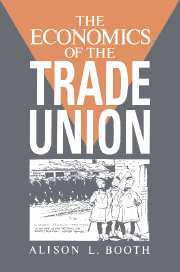Book contents
- Frontmatter
- Contents
- List of figures
- List of tables
- Preface
- 1 Introduction
- 2 The development of the union movements of Britain and the United States
- 3 The orthodox theoretical framework: an overview
- 4 Trade union objectives and the monopoly union model
- 5 Bargaining models of the trade union
- 6 Empirical estimates of the union wage differential
- 7 The impact of trade unions on productivity, investment, profitability, employment and hours
- 8 Unions and the macroeconomy
- 9 Conclusion
- References
- Index
2 - The development of the union movements of Britain and the United States
Published online by Cambridge University Press: 07 October 2009
- Frontmatter
- Contents
- List of figures
- List of tables
- Preface
- 1 Introduction
- 2 The development of the union movements of Britain and the United States
- 3 The orthodox theoretical framework: an overview
- 4 Trade union objectives and the monopoly union model
- 5 Bargaining models of the trade union
- 6 Empirical estimates of the union wage differential
- 7 The impact of trade unions on productivity, investment, profitability, employment and hours
- 8 Unions and the macroeconomy
- 9 Conclusion
- References
- Index
Summary
Introduction
Why has a unique set of collective bargaining procedures and institutions emerged in Britain and the USA? How has the trade union movement managed to obtain the power that it still wields in Britain? Why is the US labour movement more fragmented? This chapter offers some answers to these questions by providing a brief outline of the development of the British and the US trade union movement up to the present. An examination of the broad historical influences associated with the development of the union movement is helpful in understanding the institutional peculiarities of the collective bargaining structure. History also informs the development of theoretical models, since historical analysis suggests necessary conditions for trade union emergence, stability and power. It must be emphasised that, in sketching a broad historical picture, many developments that are peripheral to the main theme are necessarily ignored. The interested reader wishing to pursue historical analysis is therefore referred to books that deal solely with trade union and economic history.
Table 2.1 shows trade union density, the proportion of the civilian workforce unionised, for Britain and the USA over the period 1900 to 1990. Trade union density expanded fairly steadily for both countries from 1900. An important period of union growth for Britain was the period 1905–20, whereas for the USA the main period of growth was 1935–45. For both countries, these periods of rapid growth match the introduction of a statutory right to strike (Polachek and Siebert, 1993: 280).
- Type
- Chapter
- Information
- The Economics of the Trade Union , pp. 12 - 50Publisher: Cambridge University PressPrint publication year: 1994



